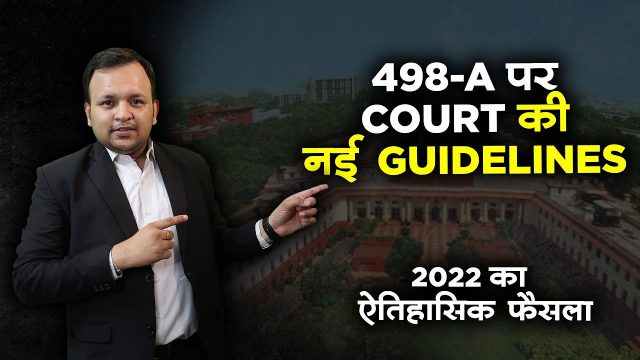In case of matrimonial disputes between a husband and a wife, the first thing that a wife can do legally is to file an F.I.R under section 498 A of the Indian Penal Code (IPC). Section 498 A sets the motion of the criminal law. The contents of the F.I.R are so similar nowadays that the misuse of this section has increased. Courts also agree that the case with false allegations is being imposed on innocent persons under 498 A. However, there are genuine cases where women are subject to cruelty by their husband or their relatives.
Due to these false allegations, many courts have started to give judgments in favor of the husband and his family. Among those judgments, the supreme court gave a landmark judgment in the case of Arnesh Kumar vs State of Bihar (2014). In this judgment, the court said that if you want to file a complaint under section 125 then you need to file a complaint under section 41 A notice first. Also, only if the injury of the victim is grave and serious then only can the police arrest the husband and his family.
After the judgment of the supreme court, many things have changed. Recently, Uttar Pradesh High Court also passed a pathbreaking judgment that take a step further by issuing guidelines for 498 A. here in this blog we will talk about that judgment of the Uttar Pradesh high court.
Mukesh Bansal vs state of UP & another, 2022
- Women filled a complaint under section 498 A against her husband and in-laws. After investigation, a charge sheet was filed against her husband’s family.
- The charge was challenged by the husband’s family in the Allahabad high court.
- The court finds the charges absurd. There was a sexual allegation against the male members of the husband’s family.
- This has become quite common nowadays that such allegations are filled under section 498 A.
- The court allows the petition against the mother-in-law and father-in-law and releases them from the charge. But the husband was charged with 498 A there the court would not interfere in the charge stage. And, dismisses the petition against the husband.
Although the husband’s petition was not successful it was a relief for the mother-in-law and father-in-law to be removed from charge. Now, honorable courts have also accepted that 498 A is being misused by charging false allegations against the husband’s family.
Section 354 of the Indian Penal Code is evoked when an F.I.R. from the women’s side is filled. This section talks about assault or criminal force on to a woman with intent to outrage her modesty. Father-in-law, and brother-in-law are generally charged with such charges. Sometimes, they are charged with rape. There are genuine cases also must the cases with false allegations are much more than genuine cases. The court does not believe that most of the men of society have such low moral values.
Guidelines for 498 A
With the conclusion of this case, the honorable court decided to introduce 4 guidelines to stop the misuse of this section. Here they are the following guidelines: –
- After an F.I.R. is registered under section 498 A there shall be no arrest for up to 2 months.
- This period of 2 months is called as cooling period.
- Also, after registering this complaint will be sent to Family Welfare Committee.
- The committee will analyze the situation and decide what is right and wrong in the 2 months.
- This was a pathbreaking judgment of no arrest for 2 months.
- Although if there is any injury or physical abuse on the woman then there can be arrested.
- In the family welfare committee, there shall be 4 senior members of both families
- This committee will record the statements and examine the story of both sides for 2 months. Then send the report back to the police station. By giving both sides time of 2 months there is hope for reconciliation between them.
- The investigation shall be conducted by a trained investigation officer (IO). The investigation officer must be particularly trained for conducting an investigation on such cases for at least a week. Sometimes when the officer is not trained, they may not directly arrest the accused person.
Section 41 A CrPC
Also after the judgment of the supreme court in Arnesh Kumar vs State of Bihar (2014) it is necessary to send notice of 41 A CrPC. The notice of 41 A is used to notify the person of his possible arrest so he can come forward and explain his part in the matter. If the person notified does not comply with the investigation, then the arrest can be made. If any police officer does not follow the judgment, then he shall be punished for contempt of court. Also, if the judicial officer does not follow the judgment, then they shall also be punished and remanded for it.
Conclusion
The high court of Allahabad has issued the above-mentioned 4 guidelines to prevent the misuse of Section 498 A. These guidelines come with the realization by the courts that many women file false allegations against her husband’s families. These types of allegations have similar patterns and stories which made the courts doubt the creditworthiness of these allegations. With the introduction of these guidelines, there is hope to cease the abuse on the husband and his family.
Feel free to connect with us, for a better understanding of legal concepts!
If still doubts persist, consult legal experts at












